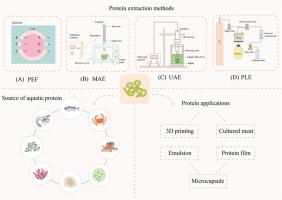Blue food proteins: Novel extraction technologies, properties, bioactivities and applications in foods
IF 6.2
2区 农林科学
Q1 FOOD SCIENCE & TECHNOLOGY
引用次数: 0
Abstract
With the growing demand for healthy and sustainable food, blue food proteins have emerged as an important way to address resource-intensive production and environmental concerns. This paper systematically reviewed the extraction technologies, properties and bioactivities of blue food proteins and explored their wide range of applications. The novel extraction technologies not only improve the extraction efficiency of the proteins, shorten the production time and have environmental advantages, but also enhance the protein properties and facilitate subsequent applications. The amino acid composition of the blue food proteins is close to the FAO recommended standard and better than most of the livestock proteins, with excellent solubility and water holding capacity. Some of the proteins also have significant bioactivity and show great potential for improving health. Applications include emulsions, protein films, microcapsules, food colorants, dietary supplements, 3D printing materials, and cultured meat. This paper provides theoretical support for further research and application of blue food proteins and promotes their wider application in future food products.

蓝色食品蛋白质:新型提取技术、特性、生物活性及在食品中的应用
随着人们对健康和可持续食品的需求日益增长,蓝色食品蛋白已成为解决资源密集型生产和环境问题的重要途径。本文系统综述了蓝色食品蛋白的提取技术、特性和生物活性,并探讨了其广泛的应用领域。新颖的提取技术不仅提高了蛋白质的提取效率,缩短了生产时间,具有环保优势,而且提高了蛋白质的特性,有利于后续应用。蓝色食品蛋白质的氨基酸组成接近粮农组织推荐的标准,优于大多数家畜蛋白质,具有极佳的溶解性和持水能力。其中一些蛋白质还具有显著的生物活性,在改善健康方面显示出巨大的潜力。其应用领域包括乳剂、蛋白质薄膜、微胶囊、食品着色剂、膳食补充剂、3D 打印材料和养殖肉类。本文为进一步研究和应用蓝色食品蛋白提供了理论支持,并促进其在未来食品中的广泛应用。
本文章由计算机程序翻译,如有差异,请以英文原文为准。
求助全文
约1分钟内获得全文
求助全文
来源期刊

Current Research in Food Science
Agricultural and Biological Sciences-Food Science
CiteScore
7.40
自引率
3.20%
发文量
232
审稿时长
84 days
期刊介绍:
Current Research in Food Science is an international peer-reviewed journal dedicated to advancing the breadth of knowledge in the field of food science. It serves as a platform for publishing original research articles and short communications that encompass a wide array of topics, including food chemistry, physics, microbiology, nutrition, nutraceuticals, process and package engineering, materials science, food sustainability, and food security. By covering these diverse areas, the journal aims to provide a comprehensive source of the latest scientific findings and technological advancements that are shaping the future of the food industry. The journal's scope is designed to address the multidisciplinary nature of food science, reflecting its commitment to promoting innovation and ensuring the safety and quality of the food supply.
 求助内容:
求助内容: 应助结果提醒方式:
应助结果提醒方式:


